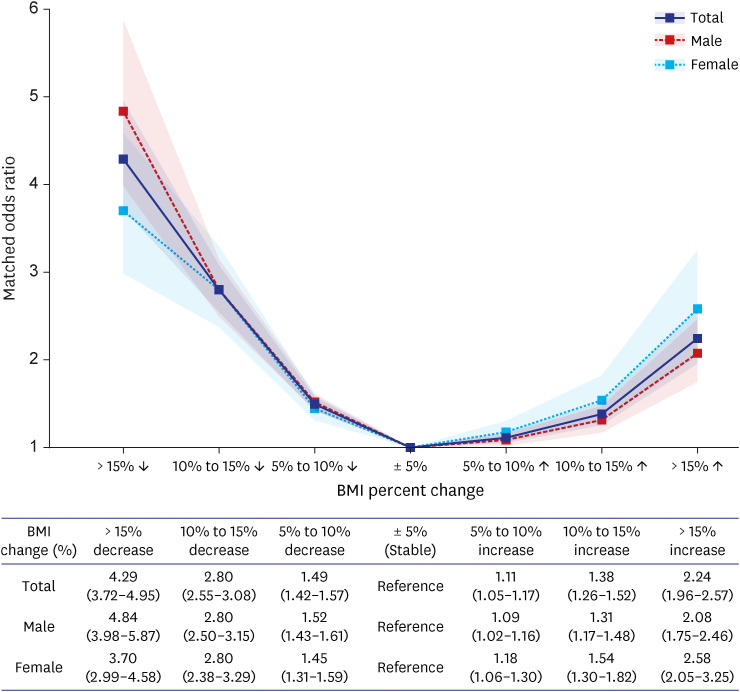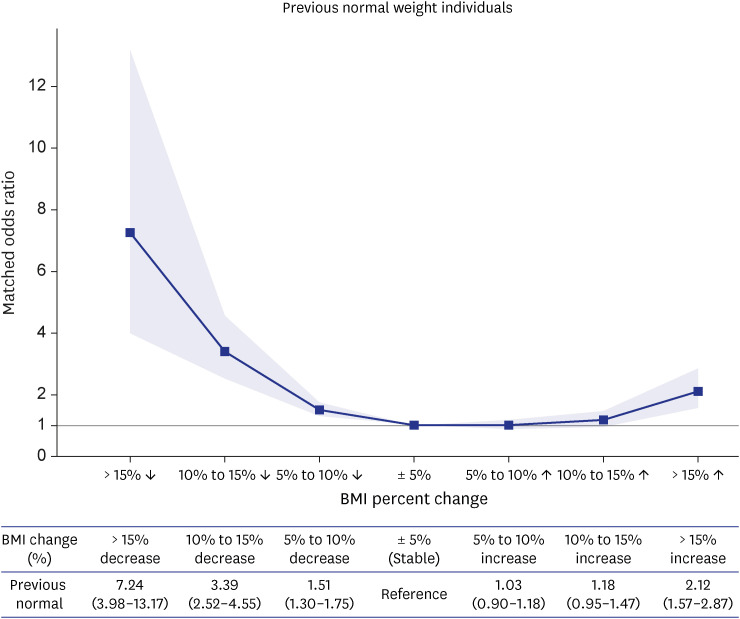J Korean Med Sci.
2023 Nov;38(43):e331. 10.3346/jkms.2023.38.e331.
Association Between Body Weight Changes and Subsequent Development of Out-of-Hospital Cardiac Arrest: A Population-Based Nested Case-Control Study
- Affiliations
-
- 1Department of Emergency Medicine, Asan Medical Center, University of Ulsan College of Medicine, Seoul, Korea
- 2Department of Clinical Epidemiology and Biostatistics, Asan Medical Center, Seoul, Korea
- KMID: 2547960
- DOI: http://doi.org/10.3346/jkms.2023.38.e331
Abstract
- Background
Body weight is a modifiable demographic factor. Although the association of body mass index (BMI) categories with sudden cardiac death was reported, dynamic changes of BMI and the risk of cardiac arrest remain unknown. This study aimed to evaluate the association between the out-of-hospital cardiac arrest (OHCA) occurrence within a year and the percent changes of BMI preceding the OHCA.
Methods
This population-based nested case-control study used the National Health Insurance Service Data of Korea. In all, 24,465 patients with non-traumatic OHCA between 2010 and 2018, who underwent national health check-up twice (one within a year and the other within 2–4 years before OHCA) and 32,434 controls without OHCA, were matched for age and sex. The association between the risk of OHCA and BMI percent change stratified by sex was investigated.
Results
All the BMI percent changes of ≥ 5% significantly increased the OHCA occurrence with a reverse J-shaped association. Compared to individuals with a stable weight, those with severe (> 15%) BMI decrease had the highest odds ratio (OR) of 4.29 (95% confidence intervals [CIs], 3.72–4.95) for OHCA occurrence followed by those with moderate (10–15%) weight loss (OR, 2.80; 95% CI, 2.55–3.08) and those with severe (> 15%) weigh gain (OR, 2.24; 95% CI, 1.96–2.57), respectively. The impact of weight loss on the cardiac arrest occurrence was more prominent in men, while the impact of weight gain was more prominent in women.
Conclusion
Significant weight changes increase the risk of OHCA within a year with a reverse J-shaped association. Significant weight loss might be a warning sign for OHCA especially for men.
Figure
Reference
-
1. Perkins GD, Graesner JT, Semeraro F, Olasveengen T, Soar J, Lott C, et al. European resuscitation council guidelines 2021: executive summary. Resuscitation. 2021; 161:1–60. PMID: 33773824.2. Hwang SO, Cha KC, Jung WJ, Roh YI, Kim TY, Chung SP, et al. 2020 Korean guidelines for cardiopulmonary resuscitation. Part 2. Environment for cardiac arrest survival and the chain of survival. Clin Exp Emerg Med. 2021; 8(S):S8–SS14. PMID: 34034446.
Article3. Lavie CJ, Arena R, Alpert MA, Milani RV, Ventura HO. Management of cardiovascular diseases in patients with obesity. Nat Rev Cardiol. 2018; 15(1):45–56. PMID: 28748957.
Article4. Arnett DK, Blumenthal RS, Albert MA, Buroker AB, Goldberger ZD, Hahn EJ, et al. 2019 ACC/AHA guideline on the primary prevention of cardiovascular disease: a report of the American College of Cardiology/American Heart Association task force on clinical practice guidelines. Circulation. 2019; 140(11):e596–e646. PMID: 30879355.5. Aune D, Schlesinger S, Norat T, Riboli E. Body mass index, abdominal fatness, and the risk of sudden cardiac death: a systematic review and dose-response meta-analysis of prospective studies. Eur J Epidemiol. 2018; 33(8):711–722. PMID: 29417316.
Article6. Dwivedi AK, Dubey P, Cistola DP, Reddy SY. Association between obesity and cardiovascular outcomes: updated evidence from meta-analysis studies. Curr Cardiol Rep. 2020; 22(4):25. PMID: 32166448.
Article7. Chalkias A, Xanthos T. The obesity paradox in cardiac arrest patients. Int J Cardiol. 2014; 171(2):101–102. PMID: 24360157.
Article8. Chen C, Ye Y, Zhang Y, Pan XF, Pan A. Weight change across adulthood in relation to all cause and cause specific mortality: prospective cohort study. BMJ. 2019; 367:l5584. PMID: 31619383.
Article9. Cheol Seong S, Kim YY, Khang YH, Heon Park J, Kang HJ, Lee H, et al. Data resource profile: the national health information database of the National Health Insurance Service in South Korea. Int J Epidemiol. 2017; 46(3):799–800. PMID: 27794523.
Article10. Cho B, Lee CM. Current situation of national health screening systems in Korea. JKMA. 2011; 54(7):666–669.
Article11. World Health Organization. Regional Office for the Western Pacific. The Asia-Pacific Perspective: Redefining Obesity and Its Treatment. Sydney, Australia: Health Communications Australia;2000.12. Chen H, Deng Y, Li S. Relation of body mass index categories with risk of sudden cardiac death. Int Heart J. 2019; 60(3):624–630. PMID: 31105141.
Article13. Caleyachetty R, Thomas GN, Toulis KA, Mohammed N, Gokhale KM, Balachandran K, et al. Metabolically healthy obese and incident cardiovascular disease events among 3.5 million men and women. J Am Coll Cardiol. 2017; 70(12):1429–1437. PMID: 28911506.
Article14. Kim HS, Lee J, Cho YK, Park JY, Lee WJ, Kim YJ, et al. Differential effect of metabolic health and obesity on incident heart failure: a nationwide population-based cohort study. Front Endocrinol (Lausanne). 2021; 12:625083. PMID: 33716978.
Article15. Kramer CK, Zinman B, Retnakaran R. Are metabolically healthy overweight and obesity benign conditions?: a systematic review and meta-analysis. Ann Intern Med. 2013; 159(11):758–769. PMID: 24297192.
Article16. Bangalore S, Fayyad R, Laskey R, DeMicco DA, Messerli FH, Waters DD. Body-weight fluctuations and outcomes in coronary disease. N Engl J Med. 2017; 376(14):1332–1340. PMID: 28379800.
Article17. Matinrazm S, Ladejobi A, Pasupula DK, Javed A, Durrani A, Ahmad S, et al. Effect of body mass index on survival after sudden cardiac arrest. Clin Cardiol. 2018; 41(1):46–50. PMID: 29355997.
Article18. Zafrir B, Shemesh E, Leviner DB, Saliba W. Relation of change of body mass index to long-term mortality after cardiac catheterization. Am J Cardiol. 2020; 125(2):270–276. PMID: 31740019.
Article19. Kim EK, Singh D, Park JH, Park YB, Kim SI, Park B, et al. Impact of body mass index change on the prognosis of chronic obstructive pulmonary disease. Respiration. 2020; 99(11):943–953. PMID: 33264797.
Article20. Sumida K, Yamamoto S, Akizawa T, Fukuhara S, Fukuma S. Body mass index change and hospitalization risk in elderly hemodialysis patients: results from japanese dialysis outcomes and practice patterns study. Am J Nephrol. 2018; 47(1):48–56. PMID: 29393094.
Article21. Myers J, Lata K, Chowdhury S, McAuley P, Jain N, Froelicher V. The obesity paradox and weight loss. Am J Med. 2011; 124(10):924–930. PMID: 21798508.
Article22. Chiuve SE, Sun Q, Sandhu RK, Tedrow U, Cook NR, Manson JE, et al. Adiposity throughout adulthood and risk of sudden cardiac death in women. JACC Clin Electrophysiol. 2015; 1(6):520–528. PMID: 26824079.
Article23. Fontana L, Hu FB. Optimal body weight for health and longevity: bridging basic, clinical, and population research. Aging Cell. 2014; 13(3):391–400. PMID: 24628815.
Article24. Ponti F, Santoro A, Mercatelli D, Gasperini C, Conte M, Martucci M, et al. Aging and imaging assessment of body composition: from fat to facts. Front Endocrinol (Lausanne). 2020; 10:861. PMID: 31993018.
Article25. Kim YJ, Seo DW, Kang J, Huh JW, Kim KW, Kim WY. Impact of body composition status on 90-day mortality in cancer patients with septic shock: sex differences in the skeletal muscle index. J Clin Med. 2019; 8(10):1583. PMID: 31581650.
Article
- Full Text Links
- Actions
-
Cited
- CITED
-
- Close
- Share
- Similar articles
-
- Association between defoliant exposure and survival to discharge after out-of-hospital cardiac arrest
- Concept Analysis of Cardiac Arrest: Identifying the Critical Attributes and Empirical Indicators
- A Case of Cardiac Arrest due to Oculoeardiac Reflex: A Case Report
- Acute Cardiac Arrest Occurred During Removal of Foreign Body in the Esophagus
- Prognostic factors related with outcomes in out-of-hospital cardiac arrest due to pesticide poisoning in South Korea: a nationwide population-based study




